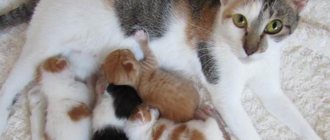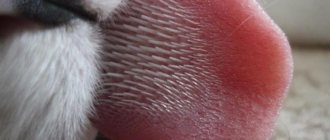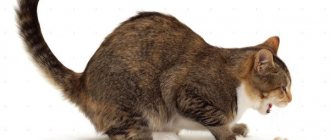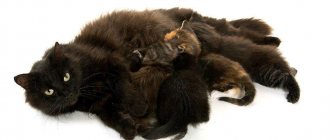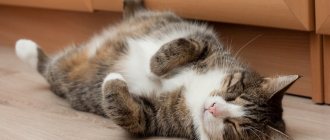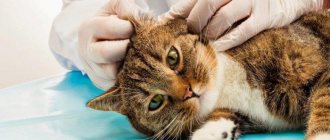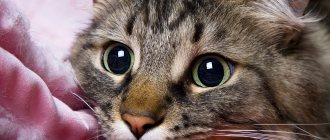What signs can you use to know that a cat is about to give birth?
A cat, just like a person, has certain signs that indicate impending birth:
- The animal is constantly kept in a box or on a bedding specially designed for childbirth.
- The cat moves around the house only to drink food or water, the rest of the time it lies and sleeps.
- If the owner gives hard and heavy food, she may refuse it completely, as an overfilled stomach leads to discomfort or pain.
- The external genitalia swell and become red.
Pregnant cat
- A small amount of red or yellow mucus may be released.
- Reddening of the nipples, the beginning of colostrum secretion, this indicates the established process of lactation.
- A few hours before the cat lambs, her mucous plug comes out, this indicates the beginning of the birth process.
- At the beginning of active contractions, the cat begins to meow loudly and protractedly.
- Often the animal tries to leave the family place, to hide from people, this should not be allowed so as not to harm the offspring.
Important! To avoid unpleasant consequences, you can first agree with a veterinarian to provide assistance during labor. There are clinics where a doctor can visit your home even at night.
Pregnancy periods in cats
The normal period for the birth of viable offspring ranges from 51 to 71 days. At the same time, for kittens from a mother of the “noble” breed, birth on the 50th day will not be a death sentence. Pedigree cats carry babies longer and most often give birth on days 63-65. It is worth special mentioning cats of the Siamese breed, which break all records and bear offspring for 69–70 days.
The main reason for such a significant difference in terms is the number of kittens carried. Thoroughbred mothers give birth to 2–4 babies, who almost always survive. A cat living under a concrete slab on the street is “genetically programmed” to give birth to as many kittens as possible, because 60–80% of them will die before they even live a year.
Note! The gestational age of a cat is too individual an indicator to “adjust” it to standards. Genetics plays an important role; if the mother of a pregnant cat gave birth at 60 days, then your pet will most likely “invest” within this time frame. Short-haired, small-built, naturally thin cats may give birth a little prematurely and this is normal.
It is believed that kittens born before 60 days are not viable. In practice, it is possible to feed a premature baby if the intestinal microflora is properly populated. The “red line” of 60 days was set for a reason; reanimated and fed kittens are most often defective.
When a cat may need help
How to measure a cat's temperature at home
When contractions begin, unforeseen circumstances may occur. If a cat cannot give birth, not every owner knows what to do at home.
There are possible complications that will require the owner's help:
- weak contractions in a cat, due to which the birth process cannot begin;
- lack of discharge of the mucus plug;
- long contractions that exhaust the animal’s body, which leads to difficulty in releasing the fetus;
- lack of cervical dilatation;
- entanglement of the kitten’s umbilical cord, which can cause it to be stillborn;
- incorrect location of the fetus, which makes it difficult to pass through the birth canal;
- the presence of blood or green or black discharge, which may indicate infection or tissue damage;
- large fetuses that cannot pass through the birth canal without outside help.
A qualified veterinarian will tell you what to do if a cat gets stuck with a kitten during birth, or other consequences occur. A prepared owner will be better able to cope with complications.
Normal and abnormal course of labor
Prevention of all possible complications during childbirth begins with caring for a pregnant cat . As soon as you discover that your pet is pregnant, regardless of whether mating was planned, she must be shown to a veterinarian.
A cat's pregnancy can be determined from 2–3 weeks using a blood test. At 3–4 weeks, the expectant mother's mammary glands swell. As the gestation period increases, the following signs are observed:
- Increased hunger.
- Redness of the nipples.
- Toxicosis.
- Slight but constant weight gain.
- Behavioral changes - frequent meowing, restlessness, unusual affection or irritability.
During the normal course of pregnancy, by about 5–6 weeks, the pet’s belly becomes noticeably rounded. If gestation proceeds without complications, the cat receives decent care, has no genetic defects, and birth occurs from 64 to 71 days of pregnancy.
Important! During the normal course of pregnancy, before the onset of contractions, the cat should not experience any discharge from the genitals. The only exception is early rejection of the mucus plug, which can occur several weeks before birth.
It will be easier for an inexperienced owner to cope with the situation if the nest for birth is prepared in advance. It is necessary to monitor the cat’s behavior; most often, she herself chooses a suitable (from her point of view) place. You can take the initiative and equip a nest for your cat from a spacious box. In order for the expectant mother to feel safe, the box must be closed (have a roof).
During the first contractions, you may find that the cat is restless, constantly entering the nest, or looking for a suitable place to give birth to kittens. The pet can meow loudly and attract the attention of the owner, especially if she is about to give birth for the first time. The first contractions bring discomfort, but the cat successfully hides the pain. The owner may not notice the discharge of amniotic fluid and the rejection of the mucous plug, since the cat licks the genital area.
As the labor process progresses, contractions will intensify and the interval between them will decrease. When the interval is reduced to 20–30 seconds, the cat will lie down on its side and prepare to push.
The first kitten takes longer to be born than all the others; to expel it, the cat will need to make 3-4 strong attempts. The total duration of the process from the start of contractions to the appearance of the first kitten can take from 2 to 24 hours. Normally, contractions last up to 12 hours, and pushing at the birth of the first kitten lasts up to 1 hour.
Note! After the birth of the first kitten, the remaining babies should appear at intervals of 10–20 minutes.
As soon as the baby is born, the cat licks its face, gnaws the umbilical cord and eats the afterbirth. If the woman in labor does not pay attention to the kitten, and the expulsion occurs too quickly, the pet may be in rapid labor. This complication is associated with severe pain, so it is advisable to immediately remove the kittens from the nest, remove fluid from the respiratory tract, rub them and place them on a heating pad.
Stimulation of labor in cats and preparation for it
If the animal has weak labor, the veterinarian may resort to medications that will stimulate the function of the uterus. It will begin to contract, which will lead to the activation of labor and the normal passage of fetuses through the birth canal.
How to help a cat in the heat: examples of what you can do
The most suitable drug is Oxytocin. This is a natural hormone that causes the uterus to contract. Its dose is calculated depending on the cat's weight. For example, if it is 5 kg, 0.3 ml is administered every hour. But there is a ban on using it more than 4 times for one animal.
Important! Increased contraction of the uterus can lead to exhaustion of the body, blockage of the birth canal and fainting.
helping a cat give birth
A cat's gestation period is 58-72 days. If the cat’s labor is good, then there is no need to use medications before and during birth. After birth, two hours after the last kitten, oxytocin can be administered to better cleanse the uterus and increase milk lactation. use of medications during cat birthFor experienced breeders this advice is unnecessary, but for beginners I would like to remind you that you are not a veterinarian. Therefore, use medications very carefully and do not try to pour and inject everything into the cat. Improper use of medications can seriously harm your cat.
traumatizing a cat during childbirth
Travmatin® acts on the neuroendocrine system, stimulates the production of endogenous (own) oxytocin, which leads to uterine contractions. In addition, Travmatin® has an analgesic and hemostatic effect. Even during normal childbirth without obstetric care, there is a risk of microtrauma to the mucous membrane of the cervix and vagina. Therefore, Travmatin® should be administered both at the beginning of labor and at the end of the process. This allows you to avoid complications both during childbirth and in the postpartum period, prevents inflammatory diseases of the genital organs and promotes normal involution of the uterus (when the uterus returns to its original state). The composition of Travmatin® in microdoses includes natural components created on the basis of plant raw materials, so it is absolutely harmless to the fetus and the mother in labor.
Dosage of the drug for cats
- 1 ml. Travmatin® is injected subcutaneously into the withers area or intramuscularly. In addition, the drug can be given orally in 5-15 drops (if it is impossible to give an injection, a very small or nervous animal), if necessary (weakening of labor in case of large fetuses or large litter size), frequent administration is possible (every 15-20 minutes).
If the postpartum period is accompanied by severe bleeding from the genitals, the animal must be given an injection of Travmatin® and consult a doctor immediately!
Don’t panic, stay calm, keep Travmatin® on hand, and your animal will give birth naturally and easily.
Gamavit for a cat during childbirth
Subcutaneously, 2 ml before birth or during childbirth as needed. Gamavit is used to normalize labor in complicated cases. The drug stimulates the smooth muscles of the uterus, accelerating and facilitating the birth process, and promotes rapid cleansing of the uterine horns from dead fetuses.
For weakened kittens, 0.01 ml subcutaneously.
oxytocin in a cat during childbirth
Oxytocin has the ability to enhance contractions of the smooth muscle of the uterus and myoepithelium of the mammary gland.
Attention!
Oxytocin can be released in different forms. Oxytocin 5 units and oxytocin 10 units. Recalculate the dosage in accordance with the purchased drug!
This drug is injected during weak labor. It causes contractions of the uterus. In most cases, oxytocin is not recommended until the first kitten is born. It is also strictly contraindicated in the case when the kitten is stuck in the birth canal.
Oxytocin is injected into the withers in a volume of 0.2-0.3 ml. One time. NOT INTO A FIGHT! If after 20 minutes there is no reaction, then inject again. In case of weak labor, they usually inject according to this scheme - 02. ml 3 times with a break of 20 minutes. You can inject intramuscularly, then the reaction will follow faster.
!!!
Oxytocin is contraindicated during obstetrics in cases of a large fetus, its deformity, as well as in case of incorrect position and position. a cocktail that stimulates labor in a cat.
If you are afraid to administer oxytocin, administer a 10 ml s.c. cocktail. No risk at all, just pure benefit. Tested in prolonged labor.
The action of the cocktail is fundamentally different from the mechanism of action of oxytocin and similar drugs (oxytocin “works” at the level of nerve fibers, “forcing” the muscles of the uterus to contract, and the cocktail stimulates the contraction of the smallest blood vessels without affecting the nerves... therefore “uterine fatigue” does not coming...
Moreover, if it is necessary to use oxytocin, “before that” it is recommended to inject such a cocktail...
In addition, the cocktail DOES NOT ALLOW uterine ruptures and bleeding, and the largest kittens are born remarkably and without problems only with its use (without the participation of oxytocin)...
You can prick UNTIL INFINITY - as much as needed = uterine fatigue DOES NOT OCCUR.
The difference between subcutaneous, intramuscular and intravenous administration is the speed of action... Roughly speaking, the result occurs subcutaneously in 10 minutes, intramuscularly in 5 minutes, intravenously - instantly.
After the birth of Supposedly the last kitten, I always inject oxytocin.
Cocktail - I inject for another 3 days, after giving birth (1 injection per day, in the same dosage as during childbirth) ... and again - reinsurance, for possible eclampsia ... NOW THE RECIPE ITSELF: 4
ml (cube) glucose 4 ml (cube) calcium gluconate 2 ml (cube) ascorbic acid Take all components into one syringe, total volume = 10 ml (cube). Inject at the rate of 2 cubes per 10 kg of cat’s weight. Single dose for a medium-sized cat = 1 ml.
Injection after the birth of the first kitten!!!
Maintains the tone of the uterus and stimulates the release of clots, replenishes fluid loss and feeds, “washes out” the placenta, stimulates milk production.
Very good during long labor. cocktail to restore strength and energy
calcium gluconate 10% -2 ml ascorbic acid - 1 ml glucose 5% - 7-10 ml For two subcutaneous injections of 10 ml every hour. The cat's weight is from 3.5 to 5 kg. Do you understand? not for stimulation, not for vitaminization, and not for prevention - To replenish what was lost!!!
This cocktail is used ONLY DURING childbirth (after 3-4 kittens) or AFTER BIRTH.
To replenish lost: strength and energy (nutrition and fluids - glucose, stress relief and removal of toxins - vitamin C, calcium.) Calcium gluconate during childbirth in a cat
Calcium gluconate or calcium borgluconate (1 ml intramuscularly)
Calcium gluconate is injected only INTRAMUSCULARLY (!!!), warmed up to body temperature (the required amount is drawn into a syringe and held in the hand until it warms up).
The drug gently enhances contractions and labor, and also promotes milk production. During childbirth, calcium is injected when regular contractions begin (see the cat's condition, if necessary). 1 ml at a time, bring to 4 ml.
After childbirth, a prophylactic dose of 1 ml once a week. If the cat shows the first signs of eclampsia, give it 1 ml in the morning and 1 ml in the evening for three days.
To relieve an attack of eclampsia, inject 2 ml, repeat after 30 minutes until the attack is completely relieved. The maximum total dose is 10 ml. You can drink calcium gluconate, but it’s useless!
In addition, it is advisable to give the cat a sedative; with the sedative, the signs of the disease go away much faster.
The veterinary drug calcium borgluconate is injected INSTEAD of calcium gluconate according to the same scheme, subcutaneously or intramuscularly. Don't solder!!!
Traumeel (traumatin) one drop in the mouth of a weakened kitten every 15 minutes for two hours.
For cats, 0.5–2 ml subcutaneously or intramuscularly to relieve pain. helping a cat during childbirth if the kitten is stuck at the exit
During the normal course of labor, you should not interfere with this natural process, you can simply help the female.
If the cat has pinched the kitten out of pain and fear, for example, in the neck area (i.e. body out, head in), then by gently pulling you can try to speed up the birth.
This is especially important in breech presentation, when compression of the umbilical cord is possible. At the same time, oxygen ceases to enter the fetal body, as a result of which a reflex inhalation follows and amniotic fluid enters the lungs. With a cephalic presentation, the membranes are open, air can pass into the lungs during breathing movements. It is better to pull the fetus by the folds of skin on the neck or torso, always during pushing, carefully, but quite strongly, as if in an arc - outward and downward. If the birth canal is dry, it needs to be moistened. a bubble is sticking out
If it is a bubble that is sticking out, then you don’t need to do anything, just don’t let the cat bite through it.
You can begin mechanical stimulation of contractions. the cat does not bite the umbilical cord.
The kitten “hangs” on the umbilical cord.
We free the kitten's nose from the amniotic sac. Grasp the umbilical cord with your thumb and forefinger as close to the cat's vulva as possible. During the contraction we stretch. If there are no contractions, but the cat jumps up and spins around, sits down (risk of crushing the kitten), cut it off. Ideally, of course, use a medical clamp. The umbilical cord was clamped. Cut off from the kitten's side. The remainder of the umbilical cord is secured with a clamp from the outside and will not go back into the cat. We bring the kitten back to life. Then we put it to the mother, she is distracted by it (licks it), and you take the clamp in your hands and remove the afterbirth. the placenta does not come out.
If the placenta hanging from the genital slit does not separate within half an hour or interferes with the birth of the next fetus, it is carefully removed by hand.
mechanical stimulation of contractions
We fix the cat in the “pooping” position. Gently massage the abdomen using circular movements. We put on gloves, dip a finger in Vaseline oil, insert it into the vagina 1 cm and make circular movements. If a bubble sticks out, then massage it around until contractions appear.
What to do if your cat can't give birth
How to trim a cat's claws: options at home
If the animal is unable to give birth on its own, even under the influence of Oxytocin, the doctor may resort to a last resort - a caesarean section. Many owners are afraid of surgery, but it is considered the safest method of treating fetuses without risking the life of the animal.
Attention! Caesarean section can only be performed in a clinical setting, as this requires sterile conditions, special instruments, medications and a resuscitation kit if necessary.
The procedure is carried out in several stages:
- they use general anesthesia, during which the cat falls asleep and cannot move;
- the peritoneum and uterus are incised;
- the fruits are removed along with the amniotic sacs and placenta;
- suturing the uterus and abdominal wall;
- use an antiseptic to eliminate the risk of infection;
- waiting for the hypnotic effect to end.
If the pregnancy was accompanied by serious complications during surgery, the doctor may recommend removing the ovaries and uterus. This prevents the possibility of further complications such as bleeding, as well as further unwanted offspring.
After the operation, it is advisable that the woman in labor stay in the clinic for another 2 or 3 days. When she begins to recover, she will be given to her owner.
Licking a kitten
The cat asks the cat what to do?
The cat asks the cat what to do? This question is asked very often by pet owners. Indeed, sometimes the physiological characteristics of a pet simply do not give anyone peace. A cat can meow both day and night. It is worth noting that quite often cats, during their spree, damage household items and their owners’ favorite items. And all this is just so that people pay attention to them. The cat went on a spree, what to do in such a situation? Let's consider the topic in more detail.
To begin with, it must be said that absolutely every owner faces this problem. The cat is yelling. A person simply has no idea what to do with her in such a situation. Most owners run to the pet pharmacy, buy mountains of some strange drugs and stuff their pet with them. However, this usually does not bring any results. A person has to again endure screams, marks and come to terms with the fact that the cat tears apart any object it comes across.
People, tired of such scenes with their pets, still bring a cat. After this, the main goal of the owners for the coming period will most likely be to distribute small fluffy balls. In the case where the cat is not purebred and has no pedigree, it is very difficult to resolve this issue. And then the owner for the first time thinks about getting rid of this problem forever.
The cat asks for a cat for the first time at the age of eight to nine months. Even if people plan to get offspring from their pet in the future, they should not pair her with a cat now. A cat at this age is too young, she may not bear kittens. As a result, inferior animals will be born. In addition, giving birth too early may not have the best effect on the cat’s health. It is easy for cat owners to determine
Source
What to do if the kitten is born too big
If you have a large fetus, it is recommended to choose one of the following methods for delivery;
- removing the kitten using forceps;
- C-section.
The first method can lead to unwanted complications for the kitten. For example, a leg may break because the muscle and bone tissue is not yet sufficiently developed. Therefore, doctors more often recommend surgery.
Cat with newborn kittens
Freeing the kitten from the amniotic sac
When the fetus is delivered along with the amniotic sac, it is recommended to apply the following rules:
- Do not pull on the umbilical cord, as this may cause a hernia.
- The umbilical cord is cut with sterile scissors with blunt ends 1 cm before the kitten's abdomen.
- The umbilical cord area is cauterized with iodine.
- If the cat does not lick the kitten, rupture the amniotic sac in the area of the kitten’s nose and suck out the fluid from the nose and mouth using an enema.
- They give the newborn to the cat so that she can lick it and apply it to the nipple.
- The placenta is counted, since each of them may not come out immediately after the kitten, but after some time.
Attention! It is extremely important to count the placenta, as if parts of it remain inside the uterus, this will lead to infection and possible death of the animal.
Newborn Sphynx kittens
Complications and help
If complications arise, the deadline often goes by minutes, you have to act quickly and clearly, so the owner should at least have an idea of what to do in case of emergency situations.
The owner of the animal is not always able to provide proper assistance to his pet, so it is recommended to get acquainted with a good veterinarian in advance and ask for his phone number.
Prolapse of amniotic sac
Amniotic sac
Normally, the sac bursts while still inside the cat, but sometimes it can come out of the vagina intact. The animal often copes on its own, bursting the bubble.
The owner can make the task easier if he makes a puncture, having first disinfected his hands. After this, you need to clean the kitten using wet wipes.
Kitten stuck in birth canal
If the kittens are large, the cat cannot do without outside help. It is recommended to lubricate the index finger of your right hand with Vaseline and, when the kitten partially appears during pushing, pull the vaginal skin towards the anus, as if picking it up from the inside.
After this, they carefully take the baby and move it in different directions to facilitate its birth.
Stillbirth in a cat
This could be not only a dead kitten, but also simply a fertilized egg that has not developed into a full-fledged embryo.
Dead kitten.
But if the egg is released without outside help, then a person must remove the dead kittens.
The simplicity of the operation is that the body can be pulled out by any part of the body, unlike a living kitten, which is not recommended to be taken by the limbs.
Under no circumstances should a dead fetus be left in the womb - this can cause inflammation and infectious diseases.
No contractions
If your pet exhibits all the prenatal symptoms: restlessness, plaintive meowing, nervous licking, swelling of the mammary glands, vaginal discharge, but no pushing, then this is a significant reason for concern.
In a standard situation, a maximum of 8 hours after your water breaks, the first kitten should be born. The maximum permissible interval between the appearance of cubs is 4 hours. If these limits are exceeded, you must urgently contact a specialist.
You cannot use stimulant drugs at your own discretion - internal organs may rupture, and the mother in labor will die along with the kittens.
What not to do during childbirth
Not all owners are aware of the ban on a number of actions during childbirth that can lead to side effects for the woman in labor:
- press on the stomach, as this can cause severe pain and harm the fetus;
- pulling the umbilical cord, which can break or lead to a hernia;
- burst the bubble yourself if the cat is able to do this;
- pick up kittens from animals that require licking and breastfeeding;
- use contaminated instruments that may cause infection;
- inject yourself with various drugs without a doctor’s permission;
- stimulate the labor process with medications if it is proceeding normally.
Not every owner knows what to do if the cat’s birth had complications, or how to help in this situation. It is better to consult a doctor who can count all the placenta, determine the time of birth, and speed up the process if necessary.
How to prevent a cat from giving birth?
Only sterilization or keeping the cat at home will help. If the cat is young, she will tolerate the operation normally and everything will be fine in 7-10 days. You'll have to look after it a little, but what did you want? There are no miracle cures. I also have a private house, but the cat lives in one room and does not go outside unattended. I sometimes go out into the yard with her on a harness. This is the second method if sterilization disgusts you. But I don’t recommend hormonal drops and pills, all kinds of countersex and sex barriers. If you lose your cat, there is a hormonal imbalance, cancer is possible at a young age!
Contact the State Duma with a request to issue a law banning births among cats)), they have a lot of experience there, based on similar works))) But seriously, get sterilization done at a veterinarian.
It's better to make sure your cat doesn't get pregnant. During the “mating” period of a cat, if the cat is domestic, you can try not to let it outside, although this is unlikely to succeed; nature will most likely take its toll, unless your cat is an apartment cat. they can still be sterilized. It is enough for a cat to give birth once, and then she can have such an operation. They also sell special drops for cats to prevent pregnancy, but it’s better to ask your veterinarian or pharmacy
Drops are not very effective, you need to determine exactly when to give them. And if my two cats give birth even once, I will have at least 10 cats. I will go crazy. I couldn’t give away 4, much less 10. - 3 years ago
The simplest, most effective and logical conclusion suggests itself - sterilization. Now it is much safer, but the effect is one hundred percent, unlike all kinds of drops and tablets. Well, if you feel sorry for cats or money, get ready to give away kittens every year.
Caring for after sterilization is not difficult, the main thing is to keep the seams clean and not let the cat lick it, there are
Source
How to care for a cat after giving birth
Immediately after the birth is completed, all afterbirths are eliminated, the animal’s body is exhausted. Therefore, we need to help him during this period:
- Provide clean water at all times to prevent dehydration.
- Feed soft, easily digestible food to normalize the digestion process, especially for cats after cesarean section.
- Keep your pet in clean conditions, change the bedding daily. Monitor the presence or absence of discharge - it can be profuse, mixed with pus if there are complications.
- Ensure peace and do not disturb the cat.
- Contact the veterinarian 1-2 times for a general examination and undergo laboratory tests as necessary.
Attention! If the cat is weak, a tray and feeder are placed next to its bedding so that it does not have to move around the room.
Helping a newborn kitten
When the fetus is born, it is surrounded by a bubble of amniotic fluid. If the cat does not lick the kitten on its own, you need help getting out of the bubble. Since the kitten has been in liquid for a long time, its mouth contains liquid. It needs to be sucked out using a pipette or a small enema.
If a cat gives birth to a kitten butt first, damage to the kitten's limbs may occur. In this case, you cannot do without the help of a veterinarian. You cannot try to fix the limbs on your own; giving medications is not recommended.
Important! After removing the kitten from the amniotic sac, it is given to the mother for licking and feeding. This is where a person’s actions end.
Kitten after being removed from the bubble
Even the cat helps the cat give birth!
Who would have thought that even a cat helps a cat give birth! Vietnamese resident Thuy Duong Panda has a cat named Yello and a cat named Tam Do. When Tam Do gave birth, her partner did not leave her side and provided all possible assistance, supporting and reassuring her.
The couple gave birth to four healthy kittens, and this was Tam Do's first birth. The kittens' father supports his beloved even after giving birth.
Take care of your pets, do not be afraid to help. You will not harm the kittens, but you will help the cat and her cubs cope with difficulties. Moreover, if necessary, you can always call a veterinarian who will tell you what to do in this or that case.
Possible complications after childbirth
If the birth was difficult, the following complications may occur:
- excessive bleeding, in which the animal requires a blood transfusion;
- damage to the tissue of the uterus or birth canal;
- severe exhaustion of the woman in labor;
- stillbirth of kittens;
- infection of the birth canal or uterus;
- the remainder of the placenta in the uterine cavity.
In most cases, it is impossible to independently identify and eliminate complications. That is why it is recommended to undergo examination at the time of birth and within 1 week after it.
When to urgently contact a veterinarian
After giving birth, the cat should gradually recover. She gains strength, she begins to move around and feed her offspring.
But there are cases when the animal becomes lethargic for a long time, and discharge forms in the genitals. The pet refuses to eat. This is a reason to contact a veterinarian. The cat's body temperature may rise greatly and convulsions may begin. All this can lead to her death if timely treatment is not started.
Childbirth is a natural process for cats, but in some cases it is complicated. Therefore, the owner needs to know what to do during this period. This applies to any pet, be it a purebred British cat or an ordinary yard cat. Complications may occur during the first or each subsequent birth.
Signs of pregnancy and impending birth
If you know the day of mating, it will be easier to determine the approximate due date. A cat bears kittens for approximately 65-67 days. Her belly begins to enlarge, her appetite increases, her nipples enlarge, becoming bright pink.
In the last days of pregnancy:
- Colostrum begins to be released from the animal's chest.
- The stomach drops.
- Body temperature decreases.
- Mucus is discharged from the vagina.
In addition, the cat begins to look for a place suitable for giving birth. You will notice that she hides in the closet, explores the distant corners of the room, etc.
On the day of birth, the animal refuses food, goes to the toilet very often, and then, when attempts appear, it begins to give birth. If your pet is giving birth for the first time, be prepared to provide all possible assistance.
